
But no worries because we have you covered. Nevertheless, it's not always easy to find an efficient audio normalization tool and – most importantly – to master the process. However, out of many different reasons, getting the best audio results from old-fashioned AD/DA converters or matching a group of audios on the same volume levels are still the most common.
WAV SOUND NORMALIZER SOFTWARE
Or simply put, normalizing any audio file with a normalizer software searches the file for a peak volume to set a defined maximum and then brings up the rest of the audio to the same maximum level.Īudio normalization is a good practice to get your audio levels right for a better-balanced video, especially imperative for dialogue clips that stand out on YouTube and other platforms.
WAV SOUND NORMALIZER HOW TO
It’s certainly possible to implement a compressor in NAudio, although there isn’t a built-in one, so I’ll cover how to make one in a future post. Compression makes the loudest bits quieter, which means that afterwards you will be able to boost the whole file without clipping.

But what if your files do have the occasional loud bit? In that case, what you want is a compressor or limiter effect. Now, as I said at the beginning, normalization is only good for files that are consistently quiet throughout.

Throw new InvalidOperationException("File cannot be normalized") Read = reader.Read(buffer, 0, buffer.Length) Ĭonsole.WriteLine($"Max sample value: ") Using (var reader = new AudioFileReader(inPath))įloat buffer = new float We’ll use Math.Abs as the maximum peak might be a negative rather than a positive peak: var inPath = max = 0 What we’ll do is read out batches of floating point samples using the Read method and find the largest value. That’s most easily done by letting NAudio convert the samples into floating point in the range +/- 1.0, and the AudioFileReader class will do that automatically for us. Normalization won’t do anything.īut having acknowledged that it doesn’t help in every situation, how can we implement it for files it is suitable for? Well we start by examining every sample value and picking out the loudest. That’s great if the entire file is quiet, but if there’s just one sample in there that already has the maximum value, then you’re stuck. So what is normalizing an audio file? It’s simply amplifying every sample in the file by the largest amount possible without causing any clipping. They simply assume it is an automatic way to make a quiet audio file louder. And I’m usually quite reluctant to answer, because often the person asking doesn’t understand the limitations of normalizing.

Every few months someone asks how you can “normalize” an audio file with NAudio.


 0 kommentar(er)
0 kommentar(er)
